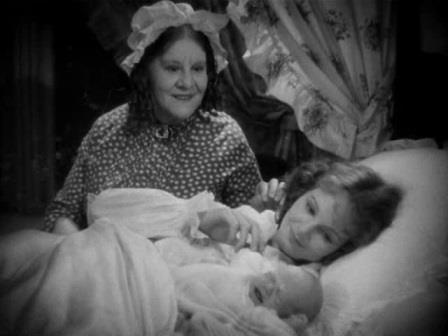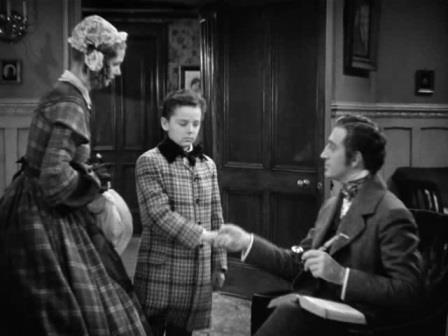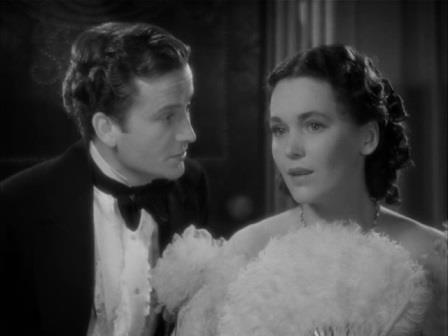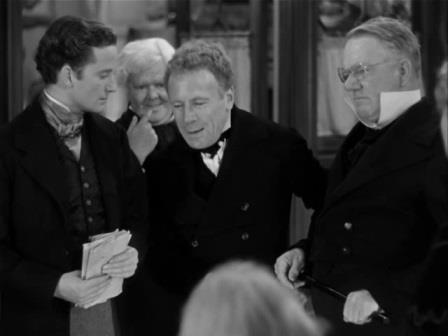“So relentlessly pursued over air and housetop, and vice versa, I have thwarted the malevolent machinations of our scurrilous enemies . . . in short, I have arrived.”—Micawber
To film historians and those movie fans with a broad viewing experience, 1935 represents the beginning of the crescendo that continued through the next three years and climaxed at the pinnacle, 1939 and its still unmatched concentration of great Hollywood films. For, after all, 1935, in a seeming creative surge after 1934, produced Mutiny on the Bounty, The Informer, Les Misérables, A Tale of Two Cities, The Lives of the Bengal Lancers, Captain Blood, A Midsummer Night’s Dream and Top Hat.
And David Copperfield. For a year, producer David O. Selznick had pestered his then boss Louis B. Mayer, head of M-G-M, to allow him to film Charles Dickens’ novel. Mayer believed Dickens scholars would condemn any deviations from the original and viewers unfamiliar with the novel would be bored. Even when Mayer finally granted permission for the film, he wanted to cut it after it was made.
As for the mogul’s objections to any changes, he should not have worried: Selznick was known for his fanatical fidelity to literary classics. Six months after David Copperfield, Selznick would release another Dickens film, A Tale of Two Cities, recycling at least six of Copperfield’s stars.
 Brilliantly directed by George Cukor, but inexplicably not Oscar-nominated, David Copperfield was the first American film for young, ten-year-old Londoner Freddie Bartholomew, who is endearing in the film without being cloyingly sweet. All the stars, especially Basil Rathbone, Jessie Ralph and Roland Young, represent the exquisite, ideal casting throughout the movie. Edna May Oliver, with her comic eccentricity, could have easily stolen the show if awarded a larger part.
Brilliantly directed by George Cukor, but inexplicably not Oscar-nominated, David Copperfield was the first American film for young, ten-year-old Londoner Freddie Bartholomew, who is endearing in the film without being cloyingly sweet. All the stars, especially Basil Rathbone, Jessie Ralph and Roland Young, represent the exquisite, ideal casting throughout the movie. Edna May Oliver, with her comic eccentricity, could have easily stolen the show if awarded a larger part.
It’s W.C. Fields, however, who gives the most memorable performance. Charles Laughton, originally assigned the role of Micawber, bowed out, feeling he wasn’t doing it justice and recommended Fields. Unable to do an English accent, Fields was at least compelled to adhere strictly to the script and eliminate, for the first and only time in his films, his notorious ad-libbing. He proved ideal for the part, though he retained his unhurried, protracted delivery, with those rolling tones out of the side of his mouth.
Beyond this already amazing, diversified cast, there are other favorite old actors who enliven the screen with their sometimes eccentric, yet always flexible performances, acquiring, in the process, the quirky names Dickens often assigned his characters: Herbert Mundin as Barkis a vicar, Una O’Connor as Mrs. Gummidge, Elsa Lanchester as Clickett, Ivan Simpson as Littimer, E.E. Clive as a sheriff’s assistant and Arthur Treacher, regarded as the “perfect butler” and frequent guest on The Merv Griffin Show in the 1960s.
None of these actors appear in the following synopsis of the film:
 Much to the annoyance of an aunt-to-be, Betsey Trotwood (Oliver) is indignant when the recently widowed Clara Copperfield (Elizabeth Allan) gives birth to a boy after Betsey had insisted the baby would be a girl. She storms from the house, although she will later be David’s guardian. The young David (Bartholomew), for the moment at least, will be raised by his mother and the kind nurse Peggotty (Ralph).
Much to the annoyance of an aunt-to-be, Betsey Trotwood (Oliver) is indignant when the recently widowed Clara Copperfield (Elizabeth Allan) gives birth to a boy after Betsey had insisted the baby would be a girl. She storms from the house, although she will later be David’s guardian. The young David (Bartholomew), for the moment at least, will be raised by his mother and the kind nurse Peggotty (Ralph).
Later, Clara is courted by the domineering Mr. Murdstone (Rathbone, his character reminiscent of the overbearing husband to Anna in Anna Karenina, 1935). Peggotty, who dislikes Murdstone from the start, takes David to visit her family. The boy learns how the nurse’s brother, Dan Peggotty (Lionel Barrymore), had adopted both the orphan Little Em’ly (Fay Chaldecott) and her cousin Ham (John Buckler).
When David returns home, he discovers that Murdstone has married his mother, discharged the nurse and replaced her with his sister, Jane (Violet Kemble Cooper). Murdstone admonishes Clara for complaining about Jane and strikes David for not knowing his school lesson, even locking him in his room.
 Clara dies in childbirth and Murdstone packs David off to London where he lives and works for a while under the kindhearted Wilkins Micawber (Fields), who is always in financial straits. He is later arrested and placed in debtors’ prison, its horrors a frequent theme of Dickens.
Clara dies in childbirth and Murdstone packs David off to London where he lives and works for a while under the kindhearted Wilkins Micawber (Fields), who is always in financial straits. He is later arrested and placed in debtors’ prison, its horrors a frequent theme of Dickens.
David soon makes the dangerous journey to Dover where, once again, he has to adjust to a new environment and another person of authority. Now it’s Aunt Betsey and yet another relative, her cousin, the simple-minded Mr. Dick (Lennox Pawle). He soon finds that he likes Betsey.
Next, David goes to live with the wealthy Wickfields. The alcoholic Mr. Wickfield (Lewis Stone) shares his home with his clerk, Uriah Heep (Young), and Wickfield’s young daughter, Agnes (Marilyn Knowlden). By the time David returns from his studies in Canterbury, now a young man (Frank Lawton), a grown Agnes (Madge Evans) clearly loves him, but he ignores her.
In his absence Heep has gained a position of authority, and Micawber, now out of prison, has become his reluctant employee.
 Having moved to London, where many a Dickens youth (Pip in Great Expectations, Oliver in Oliver Twist) grows up and makes his fortune, David attends a ballet performance with his friend Steerforth (Hugh Williams). In an adjacent balcony, he meets and falls in loves with the empty-headed Dora (Maureen O’Sullivan), whom he later marries.
Having moved to London, where many a Dickens youth (Pip in Great Expectations, Oliver in Oliver Twist) grows up and makes his fortune, David attends a ballet performance with his friend Steerforth (Hugh Williams). In an adjacent balcony, he meets and falls in loves with the empty-headed Dora (Maureen O’Sullivan), whom he later marries.
In the meantime, Steerforth elopes with Em’ly, who had been engaged to Ham. When Steerforth later abandons her in Italy, Ham searches for her, only to drown while trying to rescue her from a sinking yacht.
Uriah Heep, one of Dickens’ wickedest villains, has gained enormous power through his double-dealings, but Micawber exposes his crimes to Aunt Betsey and Mr. Dick. By the time of Dora’s death, David realizes Agnes is his one true love.
Although this film synopsis omits many of the characters/actors—even with the ones included it’s a challenge to keep family relations and friends straight—far more characters in the novel have been excluded from the movie.
 The film is reminiscent of today’s melodramatic soap operas, reflective of the novel’s seemingly endless series of misfortunes, tragedies, deaths and the inevitable Dickensian coincidences. This tone is partly due to the manner of the novel’s first appearance—not as a ready-to-read, self-contained novel, but published in a serial form of nineteen one-shilling installments from May 1849 to November 1850. In each episode of thirty-two pages, Dickens had to create a climax and, at the same time, leave the reader hanging at the end, craving the resolution in the next issue. Following its serial appearance, the complete novel was published in 1850 by Bradbury and Evans, London.
The film is reminiscent of today’s melodramatic soap operas, reflective of the novel’s seemingly endless series of misfortunes, tragedies, deaths and the inevitable Dickensian coincidences. This tone is partly due to the manner of the novel’s first appearance—not as a ready-to-read, self-contained novel, but published in a serial form of nineteen one-shilling installments from May 1849 to November 1850. In each episode of thirty-two pages, Dickens had to create a climax and, at the same time, leave the reader hanging at the end, craving the resolution in the next issue. Following its serial appearance, the complete novel was published in 1850 by Bradbury and Evans, London.
Dickens said David Copperfield was his favorite among his novels, probably because it is the most autobiographical of all his works. It was the novel Sigmund Freud, a life-long Anglophile, gave to his fiancée and which David O. Selznick’s father, an emigrant from Lithuania, used to learn English.
In the film version of Gone With the Wind, to assuage the fears of the nervous ladies, Melanie Hamilton reads David Copperfield’s opening line: “Whether I shall turn out to be the hero of my own life, or whether that station will be held by anybody else, these pages must show.” The ladies’ husbands were away in the night, in Shanty Town, settling scores with the offenders of Southern womanhood. In Margaret Mitchell’s novel, however, the book is Victor Hugo’s Les Misérables.
In London’s The Guardian, in his list of the one hundred best novels in the English language, Robert McCrum ranks David Copperfield No. 15. First is John Bunyan’s The Pilgrim’s Progress (1678). Not surprising perhaps from a British scholar and a British publication, British writers prevail until No. 10 and an American, Edgar Allan Poe and his The Narrative of Arthur Gordon Pym of Nantucket (1838).
